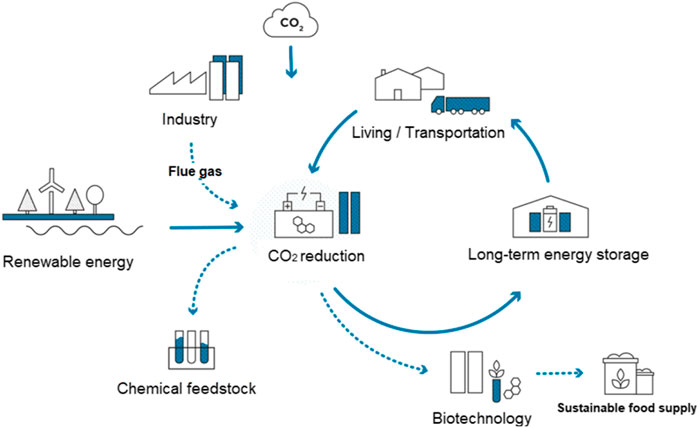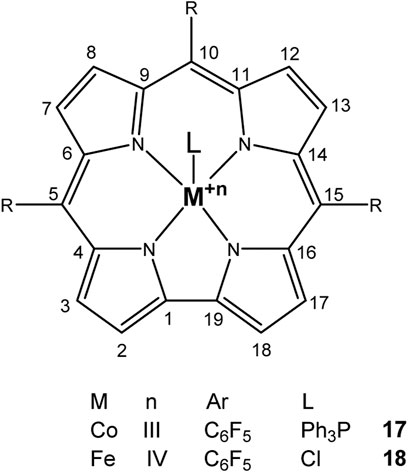Recent Progress in (Photo-)-Electrochemical Conversion of CO2 With Metal Porphyrinoid-Systems
- 1Institute of Organic Chemistry, Johannes Kepler University Linz, Linz, Austria
- 2IMC Fachhochschule Krems, Krems an der Donau, Austria
Since decades, the global community has been facing an environmental crisis, resulting in the need to switch from outdated to new, more efficient energy sources and a more effective way of tackling the rising carbon dioxide emissions. The activation of small molecules such as O2, H+, and CO2 in a cost—and energy-efficient way has become one of the key topics of catalysis research. The main issue concerning the activation of these molecules is the kinetic barrier that has to be overcome in order for the catalyzed reaction to take place. Nature has already provided many pathways in which small molecules are being activated and changed into compounds with higher energy levels. One of the most famous examples would be photosynthesis in which CO2 is transformed into glucose and O2 through sunlight, thus turning solar energy into chemical energy. For these transformations nature mostly uses enzymes that function as catalysts among which porphyrin and porphyrin-like structures can be found. Therefore, the research focus lies on the design of novel porphyrinoid systems (e.g. corroles, porphyrins and phthalocyanines) whose metal complexes can be used for the direct electrocatalytic reduction of CO2 to valuable chemicals like carbon monoxide, formate, methanol, ethanol, methane, ethylene, or acetate. For example the cobalt(III)triphenylphosphine corrole complex has been used as a catalyst for the electroreduction of CO2 to ethanol and methanol. The overall goal and emphasis of this research area is to develop a method for industrial use, raising the question of whether and how to incorporate the catalyst onto supportive materials. Graphene oxide, multi-walled carbon nanotubes, carbon black, and activated carbon, to name a few examples, have become researched options. These materials also have a beneficial effect on the catalysis through for instance preventing rival reactions such as the Hydrogen Evolution Reaction (HER) during CO2 reduction. It is very apparent that the topic of small molecule activation offers many solutions for our current energy as well as environmental crises and is becoming a thoroughly investigated research objective. This review article aims to give an overview over recently gained knowledge and should provide a glimpse into upcoming challenges relating to this subject matter.
Introduction
The aim of this review is to give an overview of different metal porphyrinoid electrocatalysts and to outline their ability to activate and reduce CO2. In order to explain the difficulties of this electrocatalytic process, we discuss the mechanisms of CO2 reduction and show current of such catalysts. The most recent findings in catalyst development, in respect to different metal ions as central atoms and ligand systems used are discussed in detail.
Porphyrins, Corroles, and Phthalocyanines
Porphyrins are naturally occurring cyclic macromolecules, which consist of four pyrrole rings connected via methine groups. Corroles differ from porphyrins as one of the methine groups is missing. In phthalocyanine macrocycles, four isoindole groups are linked together via nitrogen bridges. Figure 1 presents the general structures of porphyrin, corrole, and phthalocyanine with IUPAC numeration. The positions 5, 10, and 15 (or 5, 10, 15, and 20 in case of porphyrin) are called meso-positions (Moss, 1988; Sorokin, 2013; Zhang et al., 2017a; Barata et al., 2017).
Porphyrin and corrin derivatives are responsible for many important biochemical processes and often play an important role in living organisms, mainly serving as biocatalysts. These macrocycles serve as ligands as they tend to form coordinative bonds between the nitrogen atoms of the pyrrole units and transition metal ions such as Fe, Ni or even alkaline earth metals such as Mg.
A well-known example of a naturally occurring tetrapyrrole system is hemoglobin. The central atom of the compound (iron) forms coordinative bonds with oxygen and enables the oxygen transport in blood. Another example is chlorophyll, the green pigment present in plants, algae, and some bacteria. This complex of chlorin (reduced structure of porphyrin) with magnesium ion is responsible for the conversion of solar energy into chemical energy during photosynthesis. Cofactor F430 and cobalamin (vitamin B12) are other examples of naturally occurring tetrapyrroles. Despite similar properties, corroles, and phthalocyanines have not been isolated from natural sources so far (Shooling-Jordan and Cheung, 1999; Layer et al., 2010; Sorokin, 2013; Sawicki et al., 2015).
Coordinatively bonded tetrapyrrole systems strongly absorb electromagnetic radiation in the in the visible range. These compounds typically are highly stable in the solid and solution states, which simplifies characterization and structure elucidation and furthermore provides advantages for mechanistic investigations. Tetrapyrrol systems are easily modified and/or functionalized which paves the way for sophisticated applications in various ways. Changing substituents at meso- and β-positions as well as introducing additional functional groups at the second coordination sphere enables precise tuning of chemical and physical properties. Such modifications also include metalation, synthesis of macrocycles from previously functionalized educts or postfunctionalization of the inner core on peripheral positions. Examples of such modifications are halogenation, formylation, carboxylation, nitration, amination, sulfonation, oligomerization, chlorosulfonation, nucleophilic aromatic substitution or metal catalyzed cross-coupling reactions (Paolesse et al., 2001; Vicente and Smith, 2014; Barata et al., 2017; Hiroto et al., 2017; Orłowski et al., 2017; Nardis et al., 2019).
During the metalation process, tetrapyrrol systems are deprotonated at the inner core, leading to a four-coordinated square-planar configuration of the complex. Corroles differ from porphyrins or phthalocyanines by the number of hydrogen atoms in the inner core, which leads to different behavior during the metalation process. Deprotonated corrole binds metal ions with three bonds, while porphyrin or phthalocyanine chelates to metal ions with only two bonds. The trianionic ligand derived from corrole stabilizes metal ions more effectively in high oxidation states than their analogs with increased ring size. This has a positive effect on the formation and also the cleavage of coordinative bonds which will be discussed in subsequent sections of this chapter (Hiroto et al., 2017).
Porphyrins and corroles substituted at meso and β-positions are interesting for a variety of different applications. Fine-tuning of optical, electronic, and biochemical properties of these coordination compounds is generally achieved via the installation of different functional groups whereas the nature of the functionality and the position of the modifications defines the properties of the final product. (Pinto et al., 2016; Barata et al., 2017).
Different routes towards the preparation of corroles and porphyrines have been reported. Generally, the condensation of pyrroles with the requisite aldehydes are used to establish the macrocyle. This reaction, typically catalyzed by acids, is then followed by oxidation with p-chloranil or DDQ to complete the process (Lindsey et al., 1987; Vicente and Smith, 2014; König et al., 2016; Pinto et al., 2016). Quite often, yields are low as the reactivity of intermediates increases with growing chain length, resulting in the formation of undesired side products (Blumenfeld et al., 2015). Also, the purification is often tricky and difficult to perform on larger scale. Summarizing, very often, the complicated preparation of these compounds strongly limits their potential use in the industry.
A general approach based on the strategy outlined above was reported by Lindsey’s group in 1986. Various meso-substituted porphyrins were obtained in high-overall yield when the condensation reaction of pyrrole and an aldehyde was carried out in high dilution (Lindsey et al., 1987). Initial attempts towards the preparation of corroles were quite limited in respect to the complexity of the desired final products (Paolesse et al., 1994).
A great improvement in the synthesis of meso-substituted corroles was reported by Koszarna and Gryko in 2006. By employing biphasic reaction mixtures, the authors were able to drastically improve on previously reported yields. Simultaneously bilanes, which exhibit lower solubility, precipitated from the reaction mixture, preventing the product from undergoing unwanted side reactions and oligomerization. The protocol furthermore enabled the synthesis of corroles, substituted with strongly electron-donating groups, in good overall yield. Previously reported methods did not allow the synthesis of this important class of modified corroles (Koszarna and Gryko, 2006; König et al., 2016).
Despite the progress in the preparation of tetrapyrrole systems, scale up is still economically challenging, as all protocols rely on the use of large amounts of solvents. The solution to this problem may be the use of mechanochemistry. It has been demonstrated, that solvent-free synthesis of porphyrine in ball mills is possible, giving hope for the potential industrial-scale production of this class of compounds (Shy et al., 2014).
Among other tetrapyrrolic systems, phthalocyanines seem to be the best-suited catalysts for small molecule activation (Boutin et al., 2020). These compounds provide several advantages over corroles and porphyrins. Precursors and starting materials required for the syntheses are often inexpensive, which allows for the large-scale preparation of these compounds and the preparation and the purification of the products is well-established. Similar to corroles and porphyrins, the synthesis of both symmetric as well as asymmetric phthalocyanines has been described. Fine-tuning of solubility properties in a variety of common organic solvents as well as water is possible via the addition and incorporation of appropriate substituents (Sakamoto and Ohno-Okumura, 2009; Sorokin, 2013; Nemykin et al., 2014; Denekamp et al., 2019; Araújo et al., 2020).
Electrocatalytic Reduction of CO2
Global warming and the emissions of climate-relevant gases such as carbon dioxide have been a major area of discussion in recent years and decades. Comprehensive solutions are required with respect to CO2 management in order to maintain the maximum level of global warming below a threshold of +1.75°C. Since the reduction of CO2 emissions alone will probably not be sufficient, other methods such as the storage and recycling of CO2 must also be increasingly addressed. Such concepts of CO2-recycling include thermochemical-, (bio)-electrochemical reduction or by plasma-driven catalytic reduction methods (Villano et al., 2010; Bajracharya et al., 2017; Yuan et al., 2019; Bogaerts and Centi, 2020; Liu et al., 2020) of carbon dioxide to fuels such as methane, methanol, and ethanol (Figure 2). If the electrical energy required for this conversion was solely generated from renewable sources, a completely sustainable and climate-friendly cycle would become possible (Figure 3). The electrical energy required for the reduction of CO2 could be directly obtained via light harvesting using semiconductors. As the storage of electrical energy remains an unsolved problem to date, the direct conversion of CO2 to value-added products also could serve as solution to this tricky challenge. In this respect, wind or solar energy surpassing the capacity of the power grid could be used for the production of methanol or ethanol. With the conversion of one ton of CO2 equivalents, almost 1,400 kWh of energy could be stored under ideal conditions. If necessary, the methanol can then be used again, for example, as fuel in a direct methanol/ethanol fuel cell (DMFC).
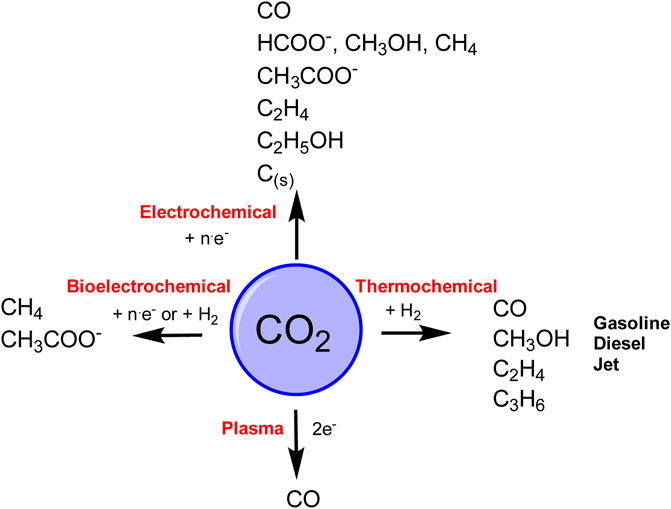
FIGURE 2. Electrochemical-, bioelectrochemical-, thermochemical- and Plasma reduction of CO2 (e−—direct pathway, H2—indirect pathway).
To date, efforts to selectively convert CO2 into methanol, ethanol or long-chain hydrocarbons continuously and at high rates have so far failed because the electrochemical reduction of CO2 is associated with several problems: 1) The solubility of CO2 in water is low and thus leads to low reaction rates. 2) The reduction of CO2 is a reaction that takes place in several steps and leads to a number of possible organic compounds. The reaction mechanism is highly dependent on the experimental conditions and it is difficult to control the selectivity of the process (Zhang et al., 2017a). The reduction of CO2 usually takes place at potentials at which the hydrogen evolution occurs. This side reaction greatly reduces the efficiency of the process (Sorokin, 2013). Additionally, the electrocatalytic activity of the respective metal catalysts might decrease significantly with time. Therefore, a thorough determination of the stability of the respective catalyst system is a necessity.
Despite the importance of the overall process, and the effort devoted to this field, answers to the questions outlined above have not yet found.
Although the reduction of CO2 and light-induced water-splitting is possible, these processes require the application of novel catalysts. The reduction of CO2 typically affords complex product mixtures. As nature has clearly demonstrated the feasibility of this approach, porphyrinoid-based catalysts seem highly suitable as catalysts as such protocols mimic photosynthesis (Mele et al., 2014; Zhang et al., 2017a; Nardis et al., 2019; Boutin et al., 2020; Min Park et al., 2020).
Reduction of Carbon Dioxide—Problematic Issue
The modern lifestyle of mankind with its continued combustion of fossil fuels has resulted in a dramatic increase of green-house gases such as CO2. The increase of CO2 in our atmosphere results in global warming and climate change (Aresta et al., 2013; Qiao et al., 2014; Álvarez et al., 2017). In 2018, the combustion of fossil fules led to an increase of the CO2-level in the atmosphere of 33.1 GT. In the same year, the emission was further increased by 1.7% (IEA, 2019). Ideally, the excess of CO2 produced by mankind should be converted in re-usable chemicals to close the circle and provide environmental stability (Qiao et al., 2014).
With the growing importance of capturing and managing man-made CO2, different technologies have been evaluated. While one approach envisages the capture of CO2 with subsequently sequester it geologically, another approach explores the conversion of CO2via chemical methods, such as photo—and electrocatalytical protocols, using homogeneous or heterogeneous catalysts (Aresta et al., 2013; Khezri et al., 2017). The latter approach would allow the production of low-carbon fuels and other important synthons for industrial processes, such as carbon monoxide (CO), formic acid (HCOOH), acetic acid (CH3COOH), methane (CH4), ethylene (C2H2), oxalate (C2O42−), formaldehyde (HCOH), and methanol (CH3OH) or ethanol (CH3CH2OH).
In the last years, the electrochemical CO2 reduction has attracted great attention and many research groups entered the quest for a sustainable economic and ecological solution of this ever-growing problem. The process of CO2 reduction is interesting as the process is easily controllable via temperature and electrode potentials. Supporting electrolytes can be fully recycled, electricity for the processes can be obtained from renewable sources, such as geothermal, solar or wind. Furthermore, the electrochemical units required for the conversion of CO2 to value-added products are compact and do not require much space (Qiao et al., 2014; Khezri et al., 2017). Although, these points sound very positive, some challenges remain. Major points are high-overpotentials, due to slow reaction kinetics, stability of catalysts and low product selectivity. As a result, one of the biggest challenges is consequently the development of new stable and selective electrocatalysts (Enthaler et al., 2010; Kondratenko et al., 2013; Qiao et al., 2014; Khezri et al., 2017).
Reactivity and Activation of Carbon Dioxide
CO2 shows a high thermodynamic stability (ΔG = −393.5 kJ mol−1) (Álvarez et al., 2017). Thus, the compounds must be activated via homogenous or heterogeneous catalysis before a transformation can take place at ambient temperature. In the case of electrocatalysis, this activation proceeds via surface-catalyzed electro-activation (Álvarez et al., 2017). Transformations of CO2 can be initiated via electrophilic activation of the oxygen or nucleophilic activation of the carbon atom. Furthermore, direct coordination to the carbon atom to the metal is also possible (Scheme 1). Moreover, CO2 can be simultaneously activated by two metal atoms, which allows for the design of highly sophisticated metal complexes as efficient and selective catalysts. (Grice, 2017; Paparo and Okuda, 2017; Kinzel et al., 2021).
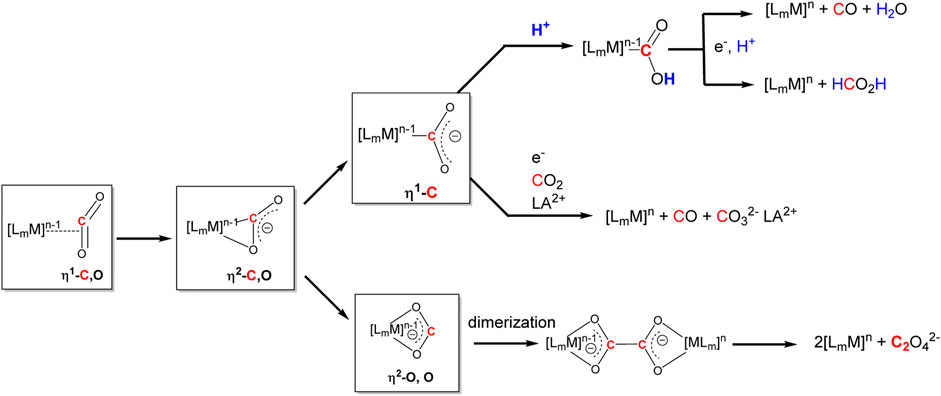
SCHEME 1. Modification possibilities for CO2 activation via transition metals. Redrawn from (Grice, 2017; Paparo and Okuda, 2017; Kinzel et al., 2021).
The electrodes and more importantly, electrocatalysts, play an important role in the product formation and product distribution. Typically, the electrocatalyst is absorbed at the cathode and interacts with CO2 during the electrochemical reduction. Charge transfer proceeds through the interface of the electrode where the catalyst is absorbed, and CO2, followed by desorption of the reduced products.
Typically, the reduction commences with the formation of a radical anion (CO2−). This initial step requires a substantial amount of energy (E0 = 1.90 V vs NHE, pH 7), as the linear molecule is converted to a bent radical anion. While this initial step is kinetically problematic, subsequent steps are typically energetically favored, driving the reaction to completion. Thermodynamic potentials of common reactions and reaction products are listed in Table 1. Generally, the overall reaction consists of a series of individual steps, including electron and proton transfer reactions (Benson et al., 2009; Zhang et al., 2017a; Khezri et al., 2017; Álvarez et al., 2017).
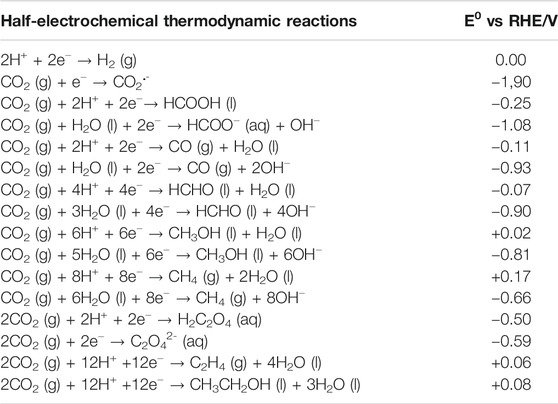
TABLE 1. Selected CO2 reduction processes and the corresponding standard redox potentials E0 for aqueous solutions (Francke et al., 2018).
Commonly, electrocatalysts are electron transfer agents, which are operating, in an ideal case, near the thermodynamic potential of the desired reaction. However, in most cases the transformation of CO2 proceeds at much higher negative potentials compared to the theoretical ones, and this results in the so-called overpotential. This additionally energy depends on the electrode, the electrolyte, the CO2-concentration, the pH value as well as the temperature and the pressure (Benson et al., 2009; Álvarez et al., 2017). This overpotential can be affected by chemical fine-tuning of the ligands of the macrocycle. Moreover, in the presence of an aqueous electrolyte, CO2 reduction becomes more challenging due to the competing hydrogen evolution reaction (HER), the low solubility and reactivity of CO2 in water, which impedes the transformation. As a consequence, the development of catalysts for electrocatalytic CO2 reduction in aqueous environment remains a big challenge. Further research is required to find methods to selectively suppress the formation of hydrogen while simultaneously favoring the reduction of CO2 (Khezri et al., 2017; Gonglach et al., 2019).
Obstacles and Possible Solutions in the Electrochemical CO2 Reduction Reaction
The high electrochemical potential required for the reduction of CO2 (E0CO2/CO2 = −1.98 V vs NHE in DMF), triggers a variety of other problems which potentially reduce the overall efficiency of the process. When oxygen is present during the electrochemical reaction, highly reactive intermediates, such as O2− or H2O2 can be formed. These side products are capable of damaging the electrode material or the electrocatalyst by oxidizing or degrading ligands. Therefore, it is important to employ catalysts which are “immune” to oxygen reduction reaction (ORR). Three different approaches have been described in the recent years. One possibility is to introduce a co-catalyst, which quenches any partially reduced oxygen species before damage can occur. Alternatively, a catalyst should be used that reduces oxygen to water. The last method is to use a catalyst which is highly selective towards CO2 so that the reduction can take place in presence of O2 (Mondal et al., 2019).
Metal Macrocycles for CO2 Electroreduction
The most investigated electrocatalysts suitable to mediate the reductive transformation of CO2 are without doubt transition metals and their corresponding metal complexes, respectively. The great potential of these metals can be attributed to their vacant orbitals and active d-electrons, where it is postulated that they favor the formation of an adduct between CO2 and the metal and promote afterwards the desorption of reduced products. The metal-type and ligand-structure play an extensive role in their catalytic behavior (Qiao et al., 2014; Kinzel et al., 2021). Generally, molecular catalysts are often less durable compared to solid-materials, since the main reduction product is CO and examples for more than two-electron reduced compounds are rare. Enormous effort was devoted to the preparation of efficient catalysts utilizing earth abundant elements, which address transition metal complexes with the most prominent metals, Fe, Cu, Co, Mn, and Ni (Takeda et al., 2017). Within the past decades, Co or Fe-macrocycles were of great interest for many research groups (Figure 3, compounds 1–11). Already in the early 1970’s Meshitsuka and co-worker found that Co- and Ni-phthalocyanines electrocatalyze CO2 reduction (Meshitsuka et al., 1974; Wang, 2017). Furthermore, in the 1980’s, the research groups of Eisenberg and Sauvage presented the electrochemical reduction of CO2 to CO via Co− and Ni-tetraazacomplexes with high selectivity (Sauvage: FE 96%, −0.86 V vs SCE) (Fisher and Eisenberg, 1980; Collin et al., 1988; Collin and Sauvage, 1989; Benson et al., 2009; Wang, 2017). In 1998, Saveánt investigated, the Fe(0)porphyrins mediated transformation of CO2 to CO in the presence of weak Brønsted acids, such as 1-propanol, 2-pyrrolidine or trifluoromethanol to facilitate the cleavage of one of the C-O bonds in CO2. Hydrogen formation could be suppressed, efficiency and lifetime enhanced. Problematic was the use of a mercury working electrode and the quite negative operating potential (−1.5 V vs SCE, DMF) (Bhugun et al., 1996a). Of course, catalytic abilities of diverse other complexes, for instance, with bipyridine or phosphine as ligands were studied which are omitted as this section emphasizes on the application of tetrapyrroles.
The publication of Grodkowski in 2002 has been the only report on CO2 reduction with Co− and Fe-corroles for a long time. Stable metal corroles, PPh3-Co(III)-TpFPC, Cl-Fe(IV)-TpFPC, Cl-Fe(IV)-TdCC [5,10,15-tris-(2,6-dichlorophenyl)corrole] were studied via chemical, electrochemical, and photochemical methods, whereas Co(I) as well as Fe(I) were identified as catalytically active species. As result, the latter Fe-macrocycle showed the highest CO2 reduction ability in acetonitrile to form CO. Compared to porphyrins, which can only react with metals with an oxidation state of zero, corroles are able to mediate transformation of CO2 with metals with an oxidation state of +I (Grodkowski et al., 2002).
More often, various examples of porphyrins are found as electrocatalysts in the literature. Robert et al. described Fe-porphyrins to be most efficient in aprotic solvents (DMF, ACN), in respect to their catalytic rate, their selectivity and robustness to yield CO. Additionally, Brønsted and Lewis acids improve catalysis as already found by Saveánt. By introduction of positively charged trimethylanilinium moieties into tetraarylporphyrins, CO2 to CO conversion is promoted via through-space substituent effects, resulted in a turnover frequency (TOF) of 106 s−1 with a low overpotential of 0.220 V and a selectivity of 100% (CO) and stability over 84 h long-term electrolysis (Azcarate et al., 2016a; Takeda et al., 2017).
CO2 Reduction With Metal Porphyrin Complexes
Iron porphyrins, illustrated in Figure 4, were first described in photocatalytic systems for CO2 reduction by Neta et al. in 1997 (Grodkowski et al., 1997). Photoexcitation of the ligand-to-metal charge transfer (LMCT) absorption band at 360 nm of a DMF/TEA (5%) solution containing compound 1 with an axial chloride ligand caused a one-electron reduction of the central metal from FeIII to FeII, simultaneously releasing the chloride ligand. The FeII species could be further reduced to FeI by triethylamine (TEA). Disproportionation of two FeI molecules produces the catalytically active Fe0 species, which coordinates to CO2. The product of the CO2 reduction was CO with a turn-over-number of the reaction of TONCO∼70, and H2 was formed as a minor product. During the catalytic process, photo-Birch reduction of the porphyrin ring occured, converting it to the corresponding chlorin structure, followed by further photochemical decomposition.
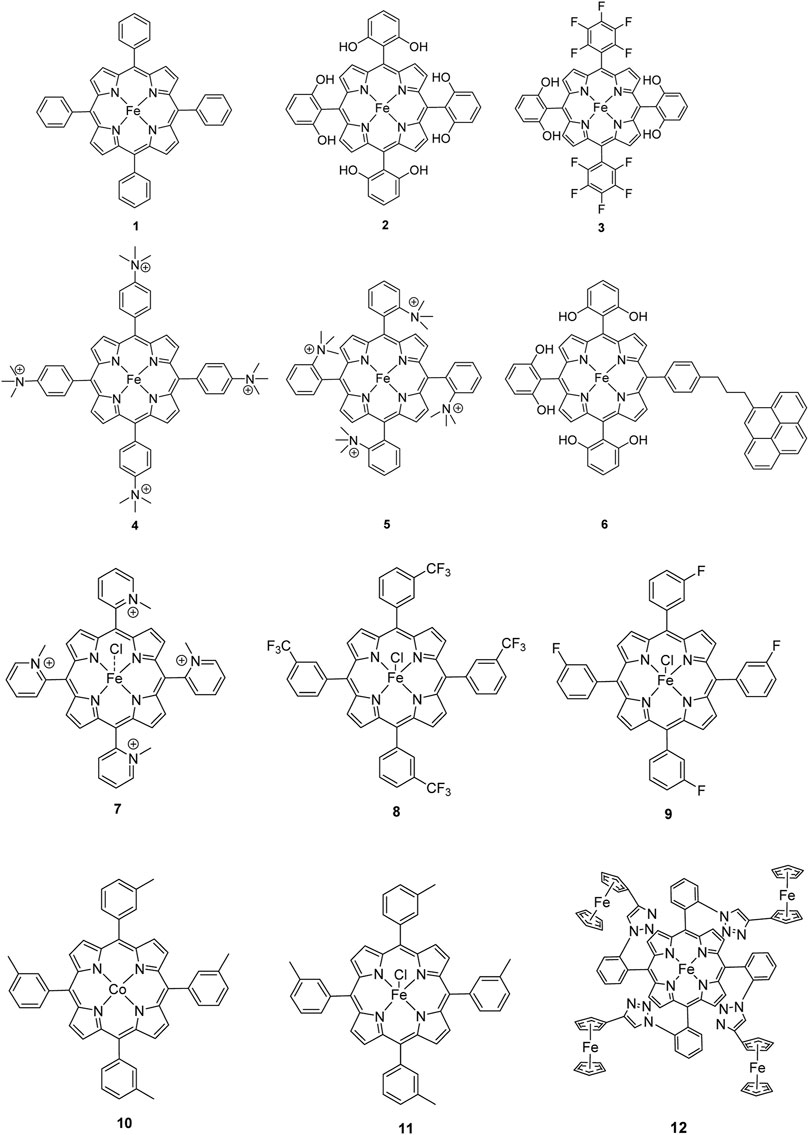
FIGURE 4. Examples of Fe− and Co-Porphyrin complexes for CO2 reduction to CO (Mondal et al., 2019).
The cationic Fe porphyrin 7 has also been reported to function as a photocatalyst, generating CO from CO2 by photoexcitation in an aqueous solution (pH 8.8) containing TEA as sacrificical electron-donor (SD) and NaHCO3. Because the efficiencies of the photochemical reduction of the Fe porphyrins were very low, the CO2 photoreduction proceeds with extremely low efficiencies. Addition of p-terphenyl as a photosensitizer (PS) to photocatalytic systems using Fe porphyrins (FeP), was investigated in order to overcome the above mentioned problems (Dhanasekaran et al., 1999). The standard reduction potential of PS-OERS of the PS was negative enough (−2.45 V vs SCE in dimethylamine) to reduce the FeIIP species −1.05 V vs SCE for 1, −1.02 V vs SCE for 8, and −1.00 V vs SCE for 9 and FeIP (−1.66 V vs SCE for 1,−1.61 V vs SCE for 8, and −1.55 V vs SCE for 9) so as to form the corresponding Fe0P species. This system exhibited 10 times higher photocatalytic efficiencies than those measured in the absence of the PS. The Co porphyrin 10 can also be used to produce CO, and its photocatalytic efficiency was about 1.5 times higher compared to that of the corresponding Fe porphyrin (11, Table 2; Dhanasekaran et al., 1999).

TABLE 2. Comparison of catalyst systems, major products, maximum FEs, and mechanisms of macrocyclic complexes in electrochemical CO2 reduction (n.a., not available; prop., proposal; comp., computational investigation; exp., experimental evidence).
A promising candidate for this particular reduction is the FeFc4-porphyrin complex 12, which has four ferrocene moieties attached and a bromide as an axial ligand (Figure 4). This particular catalyst has the ability to catalyze the reduction of O2 to H2O when the oxidation state is Fe(II) (4H+/4e−) and reduce CO2 to CO (2H+/2e−) in the presence of Fe (0). During ORR three of four ferrocenes are oxidized together with the Fe(II) center, therefore providing the four electrons to conduct the ORR (Mondal et al., 2019). In this experiment, phenol served as proton source. The two forms, Fe(II) in presence of Fe(0), are obtained by choosing two different onset-potentials to achieve the desired catalyzed reaction. Those onset-points are determined through cyclic voltammetry and the cyclic voltametric responses. In case of the FeFc4-porphyrin complex the needed potentials are 0.0 V to −0.67 V for the ORR and −2.50 V for CO2RR. Overall, the CO2 reduction to CO happens with a Faradaic efficiency of >92%.
The selectivity of this porphyrin complex is confirmed by inducing the CO2 reduction in the presence of O2 and maintaining the catalytic current for the CO2RR at −2.50 V even when the pressure of O2 is increased. Bulk electrolysis with 20% O2 shows that only 5–6% partially reduced oxygen species are found, produced by this porphyrin-complex when the oxidation state is Fe(II). However, the oxidation of the Fe(0) porphyrin-complex by O2 happens rather unlikely, given that the Faradaic yield for the CO2RR is 43% when a 1:3 mixture of CO2:O2 is induced. The selectivity of the Fe (0) porphyrin-complex for CO2RR over ORR can be argued in different ways. Thermodynamically speaking, the formation of Fe(II)-O22− is favored over Fe(II)-CO22− with a difference in absolute free energy of around 22.68 kcal/mol, showing that thermodynamics are not the reason for the preference. On the other hand, reaction of the complex with both gases separately shows in absorption spectroscopy that the specific Soret-band for porphyrins shifts immediately after inducing CO2 while the reaction with O2 shows little to no change. Hence, the kinetic barrier for the reaction with CO2 is lower, making the CO2RR 500 times faster when pseudo first-order kinetics is assumed. Involving the different solubilities of the gases in acetonitrile (CO2 = 0.28 M and O2 = 0.01 M), one can determine that the rate constants for the first- and second-order are one magnitude higher for CO2 reduction (Mondal et al., 2019).
CO2 Reduction Reaction With Metal Phthalocyanine Complexes
As mentioned in previous sections, a suitable catalyst for the CO2RR should be selective to CO2 or in other words be “immune” against the hydrogen evolution reaction HER, should have a high chemical and thermal stability and be inexpensive in production. Therefore, catalysts such as porphyrins or phthalocyanines using non-noble metals and having all the above-mentioned properties are the center of investigations. (Zhang et al., 2017a) In one described case, De Riccardis et al. investigated a phthalocyanine complex metalated with Co and with pyridine as a peripheral substituent (Figure 5). The second electrochemical reduction of this complex Co(II)Pc-Pyr happens at −0.4 V vs. Ag/AgCl, resulting in a catalytically active [Co(I)Pc-Pyr−]−2 species. The Faradaic efficiency for CO reaches a total of 95% at this specific onset-potential. Such a high FE is achieved through the inductive effect of the pyridine moieties, which supports the CO2 adsorption and increases the electron affinities of the metal center. In comparison to the non-substituted CoPc complex that only has 80% FE at −0.6 V vs RHE for the conversion of CO2 to CO and polycrystalline Ag requiring at least −0.7 V to conduct the same reduction, the CoPc-Pyr shows to be a promising candidate for CO2RR. Additionally, at an onset-potential of—0.7 V vs RHE, the turnover frequency of this phthalocyanine complex is around 6.9 s−1 when 10−8 mol are present (Riccardis et al., 2020).
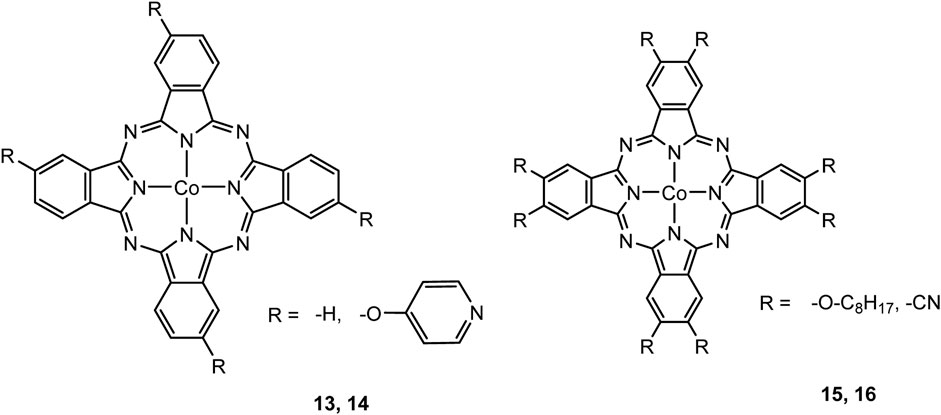
FIGURE 5. Co− and Fe phthalocyanine complexes for CO2RR (Zhang et al., 2017b).
Other examples of Mn-based molecular catalysts capable of formate formation during electrochemical CO2 reduction are the systems reported by Mahmood et al. The Mn–phthalocyanines synthesized by this research group exhibited an FE of 26% at −2.00 V vs. saturated calomel electrode (SCE) after attachment to a PTFE-bonded carbon gas diffusion electrode. Hydrogen generation (FE = 77%) exceeded the formation of formic acid, but no further mechanistic investigations were pursued (Mahmood et al., 1987).
CO2 Reduction Reaction With Metal Corrole Complexes
Metal corroles are structural similar to metal porphyrins with both the metal centers and ligands participating in multielectron redox processes and are promising candidates for efficient proton-coupled electron transfer (Zhang et al., 2017b; Hu et al., 2017; Shen et al., 2015). These metal complexes stabilize radical intermediates thus providing an effective pathway to facilitate C–C step-up. (Behar et al., 1998; Kortlever et al., 2015) Cobalt and iron corroles have been previously found to be catalytically active for CO2 reduction to CO (Figure 6; Grodkowski et al., 2002).
Our group recently reported a polyethylene glycol (PEG)-modified Mn–corrole complex immobilized on a carbon paper electrode, as an example of a manganese catalyst capable of producing MeOH (FE = 23%) and acetate (FE = 63%). (De et al., 2020) Although a detailed mechanistic investigation has not yet been performed, the authors propose an ETM pathway with a possible Mn(III) carboxyhydroxyl intermediate towards methanol formation and an oxalate type key species for acetate production. As another example for immobilized Co macrocycles in electrochemical CO2 reduction, the polyethylene glycol derivatized Co–corrole (Figure 7) reported by Gonglach et al. showed remarkable catalytic activity when used on carbon paper electrodes (Gonglach et al., 2019). More specifically, it produces ethanol and methanol in a Faradaic efficiency of 47 and 59%, respectively, at −0.73 V vs. reverse hydrogen electrode. Employment of GC‐MS (in combination with 2D‐ and 13C‐labeling), NMR, EPR, IR‐SEC, and complementary control experiments resulted in the proposed mechanism(s).
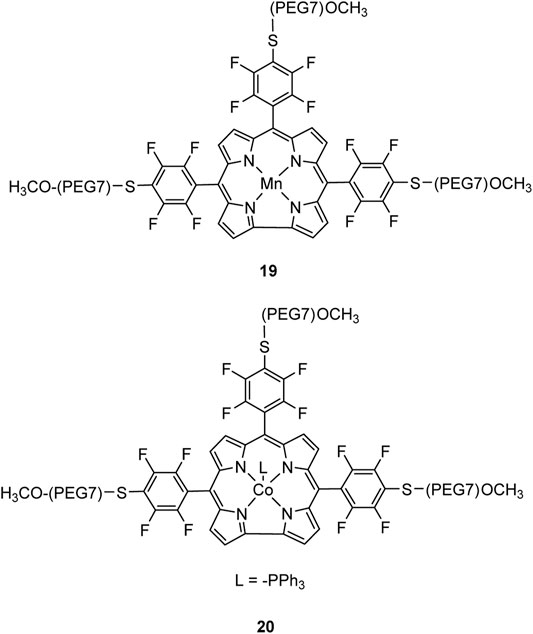
FIGURE 7. Co− and Mn-corrole complexes reported by Roy and Schöfberger et al. (Gonglach et al., 2019).
Organic Inorganic/Polymer Hybrid Materials for CO2 Reduction
Organic–inorganic hybrid materials, which are usually defined as multicomponent compounds containing organic (biological) and inorganic components in the sub-micrometric and nanometric scale can be used to integrate excellent properties, such as selectivity (Sanchez et al., 2005). In general, the organic and inorganic components can be linked by noncovalent bonds (such as van der Waals, hydrogen bonds, or electrostatic bonds) and/or covalent bonds in hybrid systems. This kind of materials not only effectively combine the advantages of organic materials (variety, flexibility, etc.) and inorganic materials (large surface area, conductivity, etc.) (Judeinstein and Sanchez, 1996; Faustini et al., 2018; Zhang et al., 2019; Rebber et al., 2020; Yang et al., 2020), but also improve the physicochemical properties, such as the increased CO2 adsorption and conductivity, enriched types of active sites, maximized exposure of active sites, and manipulated reaction pathways by tuning the stability of intermediates, thereby synergistically reducing the overpotential and promoting product selectivity (Nam et al., 2020; Sun et al., 2020). As an example, Kramer et al. grafted a cobalt metalated phthalocyanine complex onto a pyridine-substituted polymer that resulted in an increase of selectivity towards CO due to an axial coordination between carbon monoxide and the metal center (Kramer and McCrory, 2016). Immobilization of cobalt phthalocyanine in poly-4-vinylpyridine dramatically improves its activity as a catalyst for the reduction of CO2 to CO (Figure 8). The polymer membrane slows the competing HER catalytic pathway while also increasing rate of CO2RR compared to the polymer free catalyst.
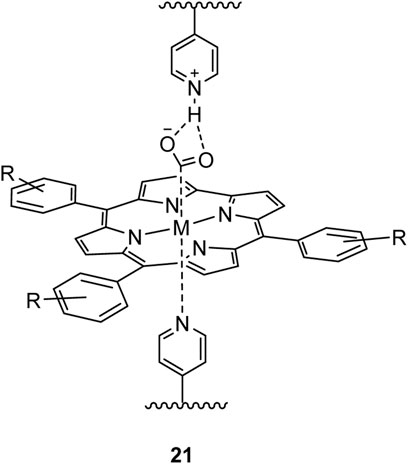
FIGURE 8. Immobilization of CoPc catalysts on P4VP (Kramer and McCrory, 2016).
Liang, Wang and co-workers showed that immobilizing the catalyst onto carbon nanotubes decreases the measured overpotential (Jiang et al., 2019). The group prepared a series of metal (Co, Fe, Mn) phthalocyanine/carbon nanotube hybrids and study their catalytic performance for CO2 electroreduction. Both CoPc/CNT and FePc/CNT are active catalysts to reduce CO2 to CO and are able to deliver a reduction current density of −1.0 mA/cm2 above −0.47 V. FePc/CNT is just slightly less active than CoPc/CNT, but superior to CoPc/CNT with higher FEs for CO at low overpotentials. Manthiram and coworkers suggest that loading catalysts onto electrodes could have a positive impact on the TOF.
Another observation of Chio et al. showed that alkoxy substituents on a cobalt phthalocyanine suppress the aggregation of the complex on graphene sheets via π-π stacking and enhance the catalytic activity per single CoPc-A molecule, resulting in FE of 75% at an overpotential of 480 mV. (Choi et al., 2019) An attractive class of solids for the CO2RR are metal-organic frameworks (MOFs), which can be used to build porous extended structures. Matheu et al. have shown that the active sites on Co are sterically accessible when applied on a 3D metal-catecholate framework/carbon black cathode materials. The 3D metal-catecholate framework was synthesized by linking tetratopic cobalt phthaloocyanin-2, 3, 9, 10, 16, 17, 23, 24-octanol linkers with Fe3 (-C2O2-)6(OH2)2 trimers. (Matheu et al., 2019) These cathodes based on MOF-1992 and carbon black (CB) display a high coverage of electroactive sites (270 nmol cm−2) and a high current density (−16.5 mA cm−2; overpotential, −0.52 V) for the CO2 to CO reduction reaction in water (faradaic efficiency, 80%). Over the 6 h experiment, MOF-1992/CB cathodes reach turnover numbers of 5,800 with turnover frequencies of 0.20 s−1 per active site (Figure 9).
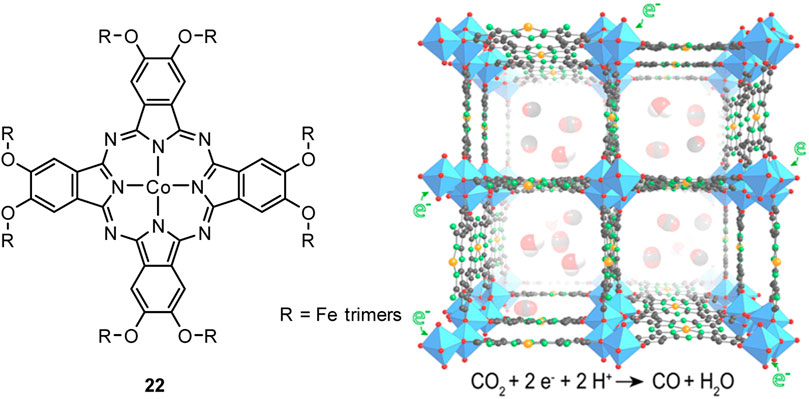
FIGURE 9. CoPc with Fe3 (-C2O2-)6(OH2)2 trimers 22 forming a 3D metal-catecholate framework. [Reprinted with permission from Matheu et al. (2019)].
Conclusion
In this mini-review, we have discussed mechanistic details of various porphyrinoid based catalyst systems during the (photo-)-electroelectrochemical CO2 reduction reaction. We have compared the electrocatalytic performance and product distribution of a variety of iron, manganese and cobalt porphyrin, corrole, and phthalocyanine complexes. The reduction efficiency of carbon dioxide by different metal porphyrinoid systems based materials can be extracted from Table 1. One of the future research directions will focus on how to regulate and modify the structure of porphyrinoids. In addition to the efficient reduction of carbon dioxide, it is necessary to consider whether the reduction products can be efficiently further employed. Next to this, one has to consider if the catalyst materials can be synthesized environmentaly friendly.
Advances in experimental techniques have revealed a wealth of mechanistic information in recent years, yet detailed operando-spectroscopic, thermodynamic and kinetic studies of proton and CO2 binding to the reduced metal catalysts would help to understand the mechanisms for CO2 reduction. Groundbreaking research has to be continued to produce renewable fuels (CO, and ultimately further reduced species such as methanol, methane, ethanol acetic acid etc.) via low-energy pathways using durable and selective earth-abundant catalysts for creating carbon-neutral energy sources.
Author Contributions
AD, DD, UR, and WS. contributed to conception and design of the review article. DD, AD, and WS wrote the first draft of the manuscript. All authors contributed to manuscript revision, read, and approved the submitted version.
Funding
Austrian Science Fund (FWF) (FWF-P28167-N34 and FWF-P32045-NBL)
Conflict of Interest
The authors declare that the research was conducted in the absence of any commercial or financial relationships that could be construed as a potential conflict of interest.
Acknowledgments
We (DD, AD, and WS) acknowledge the financial support from the Austrian Science Fund (FWF) (FWF-P28167-N34 and FWF-P32045-NBL). DD and UR thank the IMC University of Applied Sciences Krems (IMC Fachhochschule Krems) for financial support.
References
Abdinejad, M., Dao, C., Deng, B., Dinic, F., Voznyy, O., Zhang, X.-a., et al. (2020). Electrocatalytic Reduction of CO2 to CH4 and CO in Aqueous Solution Using Pyridine-Porphyrins Immobilized onto Carbon Nanotubes. ACS Sustain. Chem. Eng. 8, 9549–9557. doi:10.1021/acssuschemeng.0c02791
Abdinejad, M., Dao, C., Deng, B., Sweeney, M. E., Dielmann, F., Zhang, X. a., et al. (2020). Enhanced Electrochemical Reduction of CO2 to CO upon Immobilization onto Carbon Nanotubes Using an Iron‐Porphyrin Dimer. ChemistrySelect 5, 979–984. doi:10.1002/slct.201904580
Abdinejad, M., Seifitokaldani, A., Dao, C., Sargent, E. H., Zhang, X.-a., and Kraatz, H. B. (2019). Enhanced Electrochemical Reduction of CO2 Catalyzed by Cobalt and Iron Amino Porphyrin Complexes. ACS Appl. Energ. Mater. 2, 1330–1335. doi:10.1021/acsaem.8b01900
Abe, T., Taguchi, F., Yoshida, T., Tokita, S., Schnurpfeil, G., Wöhrle, D., et al. (1996). Electrocatalytic CO2 Reduction by Cobalt Octabutoxyphthalocyanine Coated on Graphite Electrode. J. Mol. Catal. A: Chem. 112, 55–61. doi:10.1016/1381-1169(96)00242-7
Alenezi, K. (2016). Electrocatalytic Study of Carbon Dioxide Reduction by Co(TPP)Cl Complex. J. Chem. 2016 (1501728), 7. doi:10.1155/2016/150172
Álvarez, A., Borges, M., Corral-Pérez, J. J., Olcina, J. G., Hu, L., Cornu, D., et al. (2017). CO2 Activation over Catalytic Surfaces. ChemPhysChem 18, 3135–3141. doi:10.1002/cphc.201701165
Ambre, R. B., Daniel, Q., Fan, T., Chen, H., Zhang, B., Wang, L., et al. (2016). Molecular Engineering for Efficient and Selective Iron Porphyrin Catalysts for Electrochemical Reduction of CO2 to CO. Chem. Commun. 52, 14478–14481. doi:10.1039/c6cc08099e
Aoi, S., Mase, K., Ohkubo, K., and Fukuzumi, S. (2015). Selective Electrochemical Reduction of CO2 to CO with a Cobalt Chlorin Complex Adsorbed on Multi-Walled Carbon Nanotubes in Water. Chem. Commun. 51, 10226–10228. doi:10.1039/c5cc03340c
Apaydin, D. H., Portenkirchner, E., Jintanalert, P., Strauss, M., Luangchaiyaporn, J., Sariciftci, N. S., et al. (2018). Synthesis and Investigation of Tetraphenyltetrabenzoporphyrins for Electrocatalytic Reduction of Carbon Dioxide. Sustain. Energ. Fuels 2, 2747–2753. doi:10.1039/c8se00422f
Araújo, A. R. L., Tomé, A. C., Santos, C. I. M., Faustino, M. A. F., Neves, M. G. P. M. S., Simões, M. M. Q., et al. (2020). Azides and Porphyrinoids: Synthetic Approaches and Applications. Part 2-Azides, Phthalocyanines, Subphthalocyanines and Porphyrazines. Molecules 25. doi:10.3390/molecules25071745
Aresta, M., Dibenedetto, A., and Angelini, A. (2013). Catalysis for the Valorization of Exhaust Carbon: from CO2 to Chemicals, Materials, and Fuels. Technological Use of CO2. Chem. Rev. 114, 1709–1742. doi:10.1021/cr4002758
Azcarate, I., Costentin, C., Robert, M., and Savéant, J.-M. (2016). Dissection of Electronic Substituent Effects in Multielectron-Multistep Molecular Catalysis. Electrochemical CO2-to-CO Conversion Catalyzed by Iron Porphyrins. J. Phys. Chem. C 120, 28951–28960. doi:10.1021/acs.jpcc.6b09947
Azcarate, I., Costentin, C., Robert, M., and Savéant, J.-M. (2016). Through-Space Charge Interaction Substituent Effects in Molecular Catalysis Leading to the Design of the Most Efficient Catalyst of CO2-to-CO Electrochemical Conversion. J. Am. Chem. Soc. 138, 16639–16644. doi:10.1021/jacs.6b07014
Bajracharya, S., Vanbroekhoven, K., Buisman, C. J. N., Strik, D. P. B. T. B., and Pant, D. (2017). Bioelectrochemical Conversion of CO2 to Chemicals: CO2 as a Next Generation Feedstock for Electricity-Driven Bioproduction in Batch and Continuous Modes. Faraday Discuss. 202, 433–449. doi:10.1039/c7fd00050b
Barata, J. F. B., Neves, M. G. P. M. S., Faustino, M. A. F., Tomé, A. C., Cavaleiro, J. A. S., and Cavaleiro, J. A. S. (2017). Strategies for Corrole Functionalization. Chem. Rev. 117, 3192–3253. doi:10.1021/acs.chemrev.6b00476
Behar, D., Dhanasekaran, T., Neta, P., Hosten, C. M., Ejeh, D., Hambright, P., et al. (1998). Cobalt Porphyrin Catalyzed Reduction of CO2. Radiation Chemical, Photochemical, and Electrochemical Studies. J. Phys. Chem. A. 102, 2870–2877. doi:10.1021/jp9807017
Benson, E. E., Kubiak, C. P., Sathrum, A. J., and Smieja, J. M. (2009). Electrocatalytic and Homogeneous Approaches to Conversion of CO2 to Liquid Fuels. Chem. Soc. Rev. 38, 89–99. doi:10.1039/b804323j
Bhugun, I., Lexa, D., and Savéant, J.-M. (1996). Catalysis of the Electrochemical Reduction of Carbon Dioxide by Iron(0) Porphyrins: Synergystic Effect of Weak Brönsted Acids. J. Am. Chem. Soc. 118, 1769–1776. doi:10.1021/ja9534462
Bhugun, I., Lexa, D., and Savéant, J.-M. (1996). Catalysis of the Electrochemical Reduction of Carbon Dioxide by Iron(0) Porphyrins. Synergistic Effect of Lewis Acid Cations. J. Phys. Chem. 100, 19981–19985. doi:10.1021/jp9618486
Bhugun, I., Lexa, D., and Saveant, J.-M. (1994). Ultraefficient Selective Homogeneous Catalysis of the Electrochemical Reduction of Carbon Dioxide by an Iron(0) Porphyrin Associated with a Weak Broensted Acid Cocatalyst. J. Am. Chem. Soc. 116, 5015–5016. doi:10.1021/ja00090a068
Blumenfeld, C., Fisher, K. J., Henling, L. M., Grubbs, R. H., Gray, H. B., and Virgil, S. C. (2015). Control of Oligomerization and Oxidation Steps in the Synthesis of Tris(pentafluorophenyl)corrole. Eur. J. Org. Chem. 2015, 3022–3025. doi:10.1002/ejoc.201500276
Bogaerts, A., and Centi, G. (2020). Plasma Technology for CO2 Conversion: A Personal Perspective on Prospects and Gaps. Front. Energ. Res. 8, 111. doi:10.3389/fenrg.2020.00111
Boutin, E., Merakeb, L., Ma, B., Boudy, B., Wang, M., Bonin, J., et al. (2020). Molecular Catalysis of CO2 Reduction: Recent Advances and Perspectives in Electrochemical and Light-Driven Processes with Selected Fe, Ni and Co Aza Macrocyclic and Polypyridine Complexes. Chem. Soc. Rev. 49, 5772–5809. doi:10.1039/d0cs00218f
Choi, J., Benedetti, T. M., Jalili, R., Walker, A., Wallace, G. G., and Officer, D. L. (2016). High Performance Fe Porphyrin/Ionic Liquid Co‐catalyst for Electrochemical CO2 Reduction. Chem. Eur. J. 22, 14158–14161. doi:10.1002/chem.201603359
Choi, J., Wagner, P., Gambhir, S., Jalili, R., MacFarlane, D. R., Wallace, G. G., et al. (2019). Steric Modification of a Cobalt Phthalocyanine/Graphene Catalyst to Give Enhanced and Stable Electrochemical CO2 Reduction to CO. ACS Energ. Lett. 4, 666–672. doi:10.1021/acsenergylett.8b02355
Collin, J. P., Jouaiti, A., and Sauvage, J. P. (1988). Electrocatalytic Properties of (Tetraazacyclotetradecane)nickel(2+) and Ni2(biscyclam)4+ with Respect to Carbon Dioxide and Water Reduction. Inorg. Chem. 27, 1986–1990. doi:10.1021/ic00284a030
Collin, J., and Sauvage, J. P. (1989). Electrochemical Reduction of Carbon Dioxide Mediated by Molecular Catalysts. Coord. Chem. Rev. 93, 245–268. doi:10.1016/0010-8545(89)80018-9
Costentin, C., Drouet, S., Passard, G., Robert, M., and Savéant, J.-M. (2013). Proton-Coupled Electron Transfer Cleavage of Heavy-Atom Bonds in Electrocatalytic Processes. Cleavage of a C-O Bond in the Catalyzed Electrochemical Reduction of CO2. J. Am. Chem. Soc. 135, 9023–9031. doi:10.1021/ja4030148
Costentin, C., Drouet, S., Robert, M., and Savéant, J.-M. (2012). A Local Proton Source Enhances CO2 Electroreduction to CO by a Molecular Fe Catalyst. Science 338, 90–94. doi:10.1126/science.1224581
Costentin, C., Robert, M., Savéant, J.-M., and Tatin, A. (2015). Efficient and Selective Molecular Catalyst for the CO2-to-CO Electrochemical Conversion in Water. Proc. Natl. Acad. Sci. USA 112, 6882–6886. doi:10.1073/pnas.1507063112
De, R., Gonglach, S., Paul, S., Haas, M., Sreejith, S. S., Gerschel, P., et al. (2020). Electrocatalytic Reduction of CO2 to Acetic Acid by a Molecular Manganese Corrole Complex. Angew. Chem. Int. Ed. 59, 10527–10534. doi:10.1002/anie.202000601
Denekamp, I. M., Veenstra, F. L. P., Jungbacker, P., and Rothenberg, G. (2019). A Simple Synthesis of Symmetric Phthalocyanines and Their Respective Perfluoro and Transition‐metal Complexes. Appl. Organomet. Chem. 33, e4872. doi:10.1002/aoc.4872
Dhanasekaran, T., Grodkowski, J., Neta, P., Hambright, P., and Fujita, E. (1999). p-Terphenyl-Sensitized Photoreduction of CO2 with Cobalt and Iron Porphyrins. Interaction between CO and Reduced Metalloporphyrins. J. Phys. Chem. A. 103, 7742–7748. doi:10.1021/jp991423u
Enthaler, S., von Langermann, J., and Schmidt, T. (2010). Carbon Dioxide and Formic Acid-The Couple for Environmental-Friendly Hydrogen Storage? Energy Environ. Sci. 3, 1207–1217. doi:10.1039/b907569k
Faustini, M., Nicole, L., Ruiz-Hitzky, E., and Sanchez, C. (2018). History of Organic-Inorganic Hybrid Materials: Prehistory, Art, Science, and Advanced Applications. Adv. Funct. Mater. 28, 1704158. doi:10.1002/adfm.201704158
Fisher, B. J., and Eisenberg, R. (1980). Electrocatalytic Reduction of Carbon Dioxide by Using Macrocycles of Nickel and Cobalt. J. Am. Chem. Soc. 102, 7361–7363. doi:10.1021/ja00544a035
Francke, R., Schille, B., and Roemelt, M. (2018). Homogeneously Catalyzed Electroreduction of Carbon Dioxide-Methods, Mechanisms, and Catalysts. Chem. Rev. 118, 4631–4701. doi:10.1021/acs.chemrev.7b00459
Gonglach, S., Paul, S., Haas, M., Pillwein, F., Sreejith, S. S., Barman, S., et al. (2019). Molecular Cobalt Corrole Complex for the Heterogeneous Electrocatalytic Reduction of Carbon Dioxide. Nat. Commun. 10, 3864. doi:10.1038/s41467-019-11868-5
Grice, K. A. (2017). Carbon Dioxide Reduction with Homogenous Early Transition Metal Complexes: Opportunities and Challenges for Developing CO2 Catalysis. Coord. Chem. Rev. 336, 78–95. doi:10.1016/j.ccr.2017.01.007
Grodkowski, J., Behar, D., Neta, P., and Hambright, P. (1997). Iron Porphyrin-Catalyzed Reduction of CO2. Photochemical and Radiation Chemical Studies. J. Phys. Chem. A. 101, 248–254. doi:10.1021/jp9628139
Grodkowski, J., Neta, P., Fujita, E., Mahammed, A., Simkhovich, L., and Gross, Z. (2002). Reduction of Cobalt and Iron Corroles and Catalyzed Reduction of CO2. J. Phys. Chem. A. 106, 4772–4778. doi:10.1021/jp013668o
Hammouche, M., Lexa, D., Momenteau, M., and Saveant, J. M. (1991). Chemical Catalysis of Electrochemical Reactions. Homogeneous Catalysis of the Electrochemical Reduction of Carbon Dioxide by Iron(“0”) Porphyrins. Role of the Addition of Magnesium Cations. J. Am. Chem. Soc. 113, 8455–8466. doi:10.1021/ja00022a038
Hammouche, M., Lexa, D., Savéant, J. M., and Momenteau, M. (1988). Catalysis of the Electrochemical Reduction of Carbon Dioxide by Iron(“0”) Porphyrins. J. Electroanalytical Chem. Interfacial Electrochemistry 249, 347–351. doi:10.1016/0022-0728(88)80372-3
Han, N., Wang, Y., Ma, L., Wen, J., Li, J., Zheng, H., et al. (2017). Supported Cobalt Polyphthalocyanine for High-Performance Electrocatalytic CO2 Reduction. Chem. 3, 652–664. doi:10.1016/j.chempr.2017.08.002
Hiroto, S., Miyake, Y., and Shinokubo, H. (2017). Synthesis and Functionalization of Porphyrins through Organometallic Methodologies. Chem. Rev. 117, 2910–3043. doi:10.1021/acs.chemrev.6b00427
Hu, B., Xie, W., Li, R., Pan, Z., Song, S., and Wang, Y. (2020). How Does the Ligands Structure Surrounding Metal-N4 of Co-based Macrocyclic Compounds Affect Electrochemical Reduction of CO2 Performance?. Electrochimica Acta 331, 135283. doi:10.1016/j.electacta.2019.135283
Hu, X.-M., Rønne, M. H., Pedersen, S. U., Skrydstrup, T., and Daasbjerg, K. (2017). Enhanced Catalytic Activity of Cobalt Porphyrin in CO2 Electroreduction upon Immobilization on Carbon Materials. Angew. Chem. Int. Ed. 56, 6468–6472. doi:10.1002/anie.201701104
IEA (2019). Global Energy & CO2 Status Report 2019. Available at: https://www.iea.org/reports/global-energy-co2-status-report-2019. Paris: IEA.
Jack, J., Park, E., Maness, P.-C., Huang, S., Zhang, W., and Ren, Z. J. (2020). Selective Ligand Modification of Cobalt Porphyrins for Carbon Dioxide Electrolysis: Generation of a Renewable H2/CO Feedstock for Downstream Catalytic Hydrogenation. Inorg. Chim. Acta 507, 119594. doi:10.1016/j.ica.2020.119594
Jiang, Z., Wang, Y., Zhang, X., Zheng, H., Wang, X., and Liang, Y. (2019). Revealing the Hidden Performance of Metal Phthalocyanines for CO2 Reduction Electrocatalysis by Hybridization with Carbon Nanotubes. Nano Res. 12, 2330–2334. doi:10.1007/s12274-019-2455-z
Judeinstein, P., and Sanchez, C. (1996). Hybrid Organic-Inorganic Materials: a Land of Multidisciplinarity. J. Mater. Chem. 6, 511–525. doi:10.1039/jm9960600511
Khadhraoui, A., Gotico, P., Boitrel, B., Leibl, W., Halime, Z., and Aukauloo, A. (2018). Local Ionic Liquid Environment at a Modified Iron Porphyrin Catalyst Enhances the Electrocatalytic Performance of CO2 to CO Reduction in Water. Chem. Commun. 54, 11630–11633. doi:10.1039/c8cc06475j
Khezri, B., Fisher, A. C., and Pumera, M. (2017). CO2 reduction: the Quest for Electrocatalytic Materials. J. Mater. Chem. A. 5, 8230–8246. doi:10.1039/c6ta09875d
Kinzel, N. W., Werlé, C., and Leitner, W. (2021). Transition Metal Complexes as Catalysts for the Electroconversion of CO2: An Organometallic Perspective. Angew. Chem. Int. Ed. N/a. 60(21):11628-11686. doi:10.1002/anie.202006988
Kondratenko, E. V., Mul, G., Baltrusaitis, J., Larrazábal, G. O., and Pérez-Ramírez, J. (2013). Status and Perspectives of CO2 Conversion into Fuels and Chemicals by Catalytic, Photocatalytic and Electrocatalytic Processes. Energ. Environ. Sci. 6, 3112–3135. doi:10.1039/c3ee41272e
König, M., Faschinger, F., Reith, L. M., and Schöfberger, W. (2016). The Evolution of Corrole Synthesis - from Simple One-Pot Strategies to Sophisticated ABC-Corroles. J. Porphyrins Phthalocyanines 20, 96–107. doi:10.1142/s1088424616300056
Kortlever, R., Shen, J., Schouten, K. J. P., Calle-Vallejo, F., and Koper, M. T. M. (2015). Catalysts and Reaction Pathways for the Electrochemical Reduction of Carbon Dioxide. J. Phys. Chem. Lett. 6, 4073–4082. doi:10.1021/acs.jpclett.5b01559
Koszarna, B., and Gryko, D. T. (2006). Efficient Synthesis of Meso-Substituted Corroles in a H2O−MeOH Mixture. J. Org. Chem. 71, 3707–3717. doi:10.1021/jo060007k
Kramer, W. W., and McCrory, C. C. L. (2016). Polymer Coordination Promotes Selective CO2 Reduction by Cobalt Phthalocyanine. Chem. Sci. 7, 2506–2515. doi:10.1039/c5sc04015a
Layer, G., Jahn, D., Deery, E., Lawrence, A. D., and Warren, M. J. (2010). Biosynthesis of Heme and Vitamin B12. Compr. Nat. Prod. 7, 445–499. doi:10.1016/b978-008045382-8.00144-1
Lin, S., Diercks, C. S., Zhang, Y.-B., Kornienko, N., Nichols, E. M., Zhao, Y., et al. (2015). Covalent Organic Frameworks Comprising Cobalt Porphyrins for Catalytic CO2 reduction in Water. Science 349, 1208–1213. doi:10.1126/science.aac8343
Lindsey, J. S., Schreiman, I. C., Hsu, H. C., Kearney, P. C., and Marguerettaz, A. M. (1987). Rothemund and Adler-Longo Reactions Revisited: Synthesis of Tetraphenylporphyrins under Equilibrium Conditions. J. Org. Chem. 52, 827–836. doi:10.1021/jo00381a022
Liu, C., Yuan, X., Gu, Y., Chen, H., Sun, D., Li, P., et al. (2020). Enhancement of Bioelectrochemical CO2 Reduction with a Carbon Brush Electrode via Direct Electron Transfer. ACS Sustain. Chem. Eng. 8, 11368–11375. doi:10.1021/acssuschemeng.0c03623
Liu, Y., and McCrory, C. C. L. (2019). Modulating the Mechanism of Electrocatalytic CO2 Reduction by Cobalt Phthalocyanine through Polymer Coordination and Encapsulation. Nat. Commun. 10, 1683. doi:10.1038/s41467-019-09626-8
Mahmood, M. N., Masheder, D., and Harty, C. J. (1987). Use of Gas-Diffusion Electrodes for High-Rate Electrochemical Reduction of Carbon Dioxide. II. Reduction at Metal Phthalocyanine-Impregnated Electrodes. J. Appl. Electrochem. 17, 1223–1227. doi:10.1007/bf01023606
Margarit, C. G., Asimow, N. G., Costentin, C., and Nocera, D. G. (2020). Tertiary Amine-Assisted Electroreduction of Carbon Dioxide to Formate Catalyzed by Iron Tetraphenylporphyrin. ACS Energ. Lett. 5, 72–78. doi:10.1021/acsenergylett.9b02093
Margarit, C. G., Asimow, N. G., Gonzalez, M. I., and Nocera, D. G. (2020). Double Hangman Iron Porphyrin and the Effect of Electrostatic Nonbonding Interactions on Carbon Dioxide Reduction. J. Phys. Chem. Lett. 11, 1890–1895. doi:10.1021/acs.jpclett.9b03897
Margarit, C. G., Schnedermann, C., Asimow, N. G., and Nocera, D. G. (2019). Carbon Dioxide Reduction by Iron Hangman Porphyrins. Organometallics 38, 1219–1223. doi:10.1021/acs.organomet.8b00334
Matheu, R., Gutierrez-Puebla, E., Monge, M. Á., Diercks, C. S., Kang, J., Prévot, M. S., et al. (2019). Three-Dimensional Phthalocyanine Metal-Catecholates for High Electrochemical Carbon Dioxide Reduction. J. Am. Chem. Soc. 141, 17081–17085. doi:10.1021/jacs.9b09298
Maurin, A., and Robert, M. (2016). Noncovalent Immobilization of a Molecular Iron-Based Electrocatalyst on Carbon Electrodes for Selective, Efficient CO2-to-CO Conversion in Water. J. Am. Chem. Soc. 138, 2492–2495. doi:10.1021/jacs.5b12652
Mele, G., Annese, C., D'Accolti, L., De Riccardis, A., Fusco, C., Palmisano, L., et al. (2014). Photoreduction of Carbon Dioxide to Formic Acid in Aqueous Suspension: a Comparison between phthalocyanine/TiO2 and porphyrin/TiO2 Catalysed Processes. Molecules 20, 396–415. doi:10.3390/molecules20010396
Meshitsuka, S., Ichikawa, M., and Tamaru, K. (1974). Electrocatalysis by Metal Phthalocyanines in the Reduction of Carbon Dioxide. J. Chem. Soc. Chem. Commun., 158–159. doi:10.1039/c39740000158
Min Park, J., Lee, J. H., and Jang, W.-D. (2020). Applications of Porphyrins in Emerging Energy Conversion Technologies. Coord. Chem. Rev. 407, 213157. doi:10.1016/j.ccr.2019.213157
Mohamed, E. A., Zahran, Z. N., and Naruta, Y. (2015). Efficient Electrocatalytic CO2 Reduction with a Molecular Cofacial Iron Porphyrin Dimer. Chem. Commun. 51, 16900–16903. doi:10.1039/c5cc04273a
Mondal, B., Sen, P., Rana, A., Saha, D., Das, P., and Dey, A. (2019). Reduction of CO2 to CO by an Iron Porphyrin Catalyst in the Presence of Oxygen. ACS Catal. 9, 3895–3899. doi:10.1021/acscatal.9b00529
Moss, G. P. (1988). Nomenclature of Tetrapyrroles. Recommendations 1986 IUPAC-IUB Joint Commission on Biochemical Nomenclature (JCBN). Eur. J. Biochem. 178, 277–328. doi:10.1111/j.1432-1033.1988.tb14453.x
Nam, D.-H., De Luna, P., Rosas-Hernández, A., Thevenon, A., Li, F., Agapie, T., et al. (2020). Molecular Enhancement of Heterogeneous CO2 Reduction. Nat. Mater. 19, 266–276. doi:10.1038/s41563-020-0610-2
Nardis, S., Mandoj, F., Stefanelli, M., and Paolesse, R. (2019). Metal Complexes of Corrole. Coord. Chem. Rev. 388, 360–405. doi:10.1016/j.ccr.2019.02.034
Nemykin, V. N., Dudkin, S. V., Dumoulin, F., Hirel, C., and Ahsen, A. G. V. (2014). Synthetic Approaches to Asymmetric Phthalocyanines and Their Analogues. ARKIVOC 2014, 142–204. doi:10.3998/ark.5550190.p008.412
Nichols, E. M., Derrick, J. S., Nistanaki, S. K., Smith, P. T., and Chang, C. J. (2018). Positional Effects of Second-Sphere Amide Pendants on Electrochemical CO2 Reduction Catalyzed by Iron Porphyrins. Chem. Sci. 9, 2952–2960. doi:10.1039/c7sc04682k
Ogawa, A., Oohora, K., Gu, W., and Hayashi, T. (2019). Electrochemical CO2 Reduction by a Cobalt Bipyricorrole Complex: Decrease of an Overpotential Value Derived from Monoanionic Ligand Character of the Porphyrinoid Species. Chem. Commun. 55, 493–496. doi:10.1039/c8cc08876d
Okabe, Y., Lee, S. K., Kondo, M., and Masaoka, S. (2017). Syntheses and CO2 Reduction Activities of π-expanded/extended Iron Porphyrin Complexes. J. Biol. Inorg. Chem. 22, 713–725. doi:10.1007/s00775-017-1438-3
Orłowski, R., Gryko, D., and Gryko, D. T. (2017). Synthesis of Corroles and Their Heteroanalogs. Chem. Rev. 117, 3102–3137. doi:10.1021/acs.chemrev.6b00434
Paolesse, R., Licoccia, S., Bandoli, G., Dolmella, A., and Boschi, T. (1994). First Direct Synthesis of a Corrole Ring from a Monopyrrolic Precursor. Crystal and Molecular Structure of (Triphenylphosphine)(5,10,15-triphenyl-2,3,7,8,12,13,17,18-octamethylcorrolato)Cobalt(III)-Dichloromethane. Inorg. Chem. 33, 1171–1176. doi:10.1021/ic00084a033
Paolesse, R., Nardis, S., Sagone, F., and Khoury, R. G. (2001). Synthesis and Functionalization Ofmeso-Aryl-Substituted Corroles. J. Org. Chem. 66, 550–556. doi:10.1021/jo005661t
Paparo, A., and Okuda, J. (2017). Carbon Dioxide Complexes: Bonding Modes and Synthetic Methods. Coord. Chem. Rev. 334, 136–149. doi:10.1016/j.ccr.2016.06.005
Pinto, S. M. A., Henriques, C. A., Tomé, V. A., Vinagreiro, C. S., Calvete, M. J. F., Dąbrowski, J. M., et al. (2016). Synthesis of Meso-Substituted Porphyrins Using Sustainable Chemical Processes. J. Porphyrins Phthalocyanines 20, 45–60. doi:10.1142/s1088424616300020
Qiao, J., Liu, Y., Hong, F., and Zhang, J. (2014). A Review of Catalysts for the Electroreduction of Carbon Dioxide to Produce Low-Carbon Fuels. Chem. Soc. Rev. 43, 631–675. doi:10.1039/c3cs60323g
Rebber, M., Willa, C., and Koziej, D. (2020). Organic-inorganic Hybrids for CO2 Sensing, Separation and Conversion. Nanoscale Horiz. 5, 431–453. doi:10.1039/c9nh00380k
Ren, S., Joulié, D., Salvatore, D., Torbensen, K., Wang, M., Robert, M., et al. (2019). Molecular Electrocatalysts Can Mediate Fast, Selective CO2 Reduction in a Flow Cell. Science 365, 367–369. doi:10.1126/science.aax4608
Riccardis, A. de., Lee, M., Kazantsev, R. V., Garza, A. J., Zeng, G., Larson, D. M., et al. (2020). Heterogenized Pyridine-Substituted Cobalt(II) Phthalocyanine Yields Reduction of CO2 by Tuning the Electron Affinity of the Co Center. ACS Appl. Mater. Inter. 12, 5251–5258. doi:10.1021/acsami.9b18924
Sakamoto, K., and Ohno-Okumura, E. (2009). Syntheses and Functional Properties of Phthalocyanines. Materials 2, 1127–1179. doi:10.3390/ma2031127
Sanchez, C., Julián, B., Belleville, P., and Popall, M. (2005). Applications of Hybrid Organic-Inorganic Nanocomposites. J. Mater. Chem. 15, 3559–3592. doi:10.1039/b509097k
Sawicki, K. T., Chang, H-C., and Ardehali, H. (2015). Role of Heme in Cardiovascular Physiology and Disease. J. Am. Heart Assoc. 4, 1–14. doi:10.1161/jaha.114.001138
Sen, P., Mondal, B., Saha, D., Rana, A., and Dey, A. (2019). Role of 2nd Sphere H-Bonding Residues in Tuning the Kinetics of CO2 Reduction to CO by Iron Porphyrin Complexes. Dalton Trans. 48, 5965–5977. doi:10.1039/c8dt03850c
Shen, J., Kortlever, R., Kas, R., Birdja, Y. Y., Diaz-Morales, O., Kwon, Y., et al. (2015). Electrocatalytic Reduction of Carbon Dioxide to Carbon Monoxide and Methane at an Immobilized Cobalt Protoporphyrin. Nat. Commun. 6, 8177. doi:10.1038/ncomms9177
Shooling-Jordan, P. M., and Cheung, K.-M. (1999). Biosynthesis of Heme. Compr. Nat. Prod. Chem. 4, 61–107. doi:10.1016/b978-0-08-091283-7.00161-2
Shy, H., Mackin, P., Orvieto, A. S., Gharbharan, D., Peterson, G. R., Bampos, N., et al. (2014). The Two-step Mechanochemical Synthesis of Porphyrins. Faraday Discuss. 170, 59–69. doi:10.1039/c3fd00140g
Sinha, S., and Warren, J. J. (2018). Unexpected Solvent Effect in Electrocatalytic CO2 to CO Conversion Revealed Using Asymmetric Metalloporphyrins. Inorg. Chem. 57, 12650–12656. doi:10.1021/acs.inorgchem.8b01814
Sorokin, A. B. (2013). Phthalocyanine Metal Complexes in Catalysis. Chem. Rev. 113, 8152–8191. doi:10.1021/cr4000072
Sun, L., Reddu, V., Fisher, A. C., and Wang, X. (2020). Electrocatalytic Reduction of Carbon Dioxide: Opportunities with Heterogeneous Molecular Catalysts. Energ. Environ. Sci. 13, 374–403. doi:10.1039/c9ee03660a
Takeda, H., Cometto, C., Ishitani, O., and Robert, M. (2017). Electrons, Photons, Protons and Earth-Abundant Metal Complexes for Molecular Catalysis of CO2 Reduction. ACS Catal. 7, 70–88. doi:10.1021/acscatal.6b02181
Tatin, A., Comminges, C., Kokoh, B., Costentin, C., Robert, M., and Savéant, J.-M. (2016). Efficient Electrolyzer for CO2 Splitting in Neutral Water Using Earth-Abundant Materials. Proc. Natl. Acad. Sci. USA 113, 5526–5529. doi:10.1073/pnas.1604628113
Torbensen, K., Han, C., Boudy, B., Wolff, N., Bertail, C., Braun, W., et al. (2020). Iron Porphyrin Allows Fast and Selective Electrocatalytic Conversion of CO2 to CO in a Flow Cell. Chem. Eur. J. 26, 3034–3038. doi:10.1002/chem.202000160
Vicente, M., and Smith, K. (2014). Syntheses and Functionalizations of Porphyrin Macrocycles. Cos 11, 3–28. doi:10.2174/15701794113106660083
Villano, M., Aulenta, F., Ciucci, C., Ferri, T., Giuliano, A., and Majone, M. (2010). Bioelectrochemical Reduction of CO2 to CH4via Direct and Indirect Extracellular Electron Transfer by a Hydrogenophilic Methanogenic Culture. Bioresour. Tech. 101, 3085–3090. doi:10.1016/j.biortech.2009.12.077
Wang, F. (2017). Artificial Photosynthetic Systems for CO2 Reduction: Progress on Higher Efficiency with Cobalt Complexes as Catalysts. ChemSusChem 10, 4393–4402. doi:10.1002/cssc.201701385
Wang, J., Huang, X., Xi, S., Lee, J. M., Wang, C., Du, Y., et al. (2019a). Linkage Effect in the Heterogenization of Cobalt Complexes by Doped Graphene for Electrocatalytic CO2 Reduction. Angew. Chem. Int. Ed. 58, 13532–13539. doi:10.1002/anie.201906475
Wang, M. (2019b). CO2 Electrochemical Catalytic Reduction with a Highly Active Cobalt Phthalocyanine. Nat. Commun. 10, 3602. doi:10.1038/s41467-019-11542-w
Yang, C., Li, S., Zhang, Z., Wang, H., Liu, H., Jiao, F., et al. (2020). Organic-Inorganic Hybrid Nanomaterials for Electrocatalytic CO2 Reduction. Small 16, 2001847. doi:10.1002/smll.202001847
Yuan, M., Kummer, M. J., and Minteer, S. D. (2019). Strategies for Bioelectrochemical CO2 Reduction. Chem. Eur. J. 25, 14258–14266. doi:10.1002/chem.201902880
Zahran, Z. N., Mohamed, E. A., and Naruta, Y. (2016). Bio-inspired Cofacial Fe Porphyrin Dimers for Efficient Electrocatalytic CO2 to CO Conversion: Overpotential Tuning by Substituents at the Porphyrin Rings. Sci. Rep. 6, 24533. doi:10.1038/srep24533
Zhang, W., Lai, W., and Cao, R. (2017). Energy-Related Small Molecule Activation Reactions: Oxygen Reduction and Hydrogen and Oxygen Evolution Reactions Catalyzed by Porphyrin- and Corrole-Based Systems. Chem. Rev. 117, 3717–3797. doi:10.1021/acs.chemrev.6b00299
Zhang, X., Wu, Z., Zhang, X., Li, L., Li, Y., Xu, H., et al. (2017). Highly Selective and Active CO2 Reduction Electrocatalysts Based on Cobalt Phthalocyanine/carbon Nanotube Hybrid Structures. Nat. Commun. 8, 14675. doi:10.1038/ncomms14675
Zhang, X., Chen, Z., Mou, K., Jiao, M., Zhang, X., and Liu, L. (2019). Intentional Construction of High-Performance SnO2 Catalysts with a 3D Porous Structure for Electrochemical Reduction of CO2. Nanoscale 11, 18715–18722. doi:10.1039/c9nr06354d
Zhang, Z., Xiao, J., Chen, X.-J., Yu, S., Yu, L., Si, R., et al. (2018). Reaction Mechanisms of Well-Defined Metal-N4 Sites in Electrocatalytic CO2 Reduction. Angew. Chem. Int. Ed. 57, 16339–16342. doi:10.1002/anie.201808593
Keywords: catalysis, carbon dioxide reduction, metal complexes, corroles, porphyrins, phthalocyanines, electrocatalysis
Citation: Dedić D, Dorniak A, Rinner U and Schöfberger W (2021) Recent Progress in (Photo-)-Electrochemical Conversion of CO2 With Metal Porphyrinoid-Systems. Front. Chem. 9:685619. doi: 10.3389/fchem.2021.685619
Received: 25 March 2021; Accepted: 28 June 2021;
Published: 16 July 2021.
Edited by:
Simelys Hernández, Politecnico di Torino, ItalyReviewed by:
Giovanni Palmisano, Khalifa University, United Arab EmiratesElena Pastor, University of La Laguna, Spain
Copyright © 2021 Dedić, Dorniak, Rinner and Schöfberger. This is an open-access article distributed under the terms of the Creative Commons Attribution License (CC BY). The use, distribution or reproduction in other forums is permitted, provided the original author(s) and the copyright owner(s) are credited and that the original publication in this journal is cited, in accordance with accepted academic practice. No use, distribution or reproduction is permitted which does not comply with these terms.
*Correspondence: Wolfgang Schöfberger, wolfgang.schoefberger@jku.at
 Dženeta Dedić1,2
Dženeta Dedić1,2  Adrian Dorniak
Adrian Dorniak Wolfgang Schöfberger
Wolfgang Schöfberger
